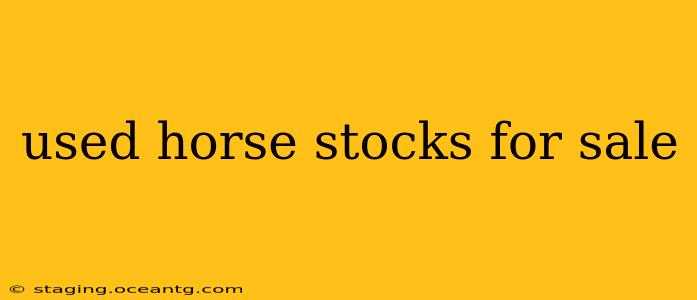Finding the right horse stock can be a challenging but rewarding experience. Whether you're a seasoned equestrian looking to upgrade your equipment or a newcomer building your stable, understanding the market for used horse stocks is crucial. This comprehensive guide will help you navigate the process, from identifying your needs to making a sound purchase.
What are Horse Stocks?
Before diving into the used market, let's clarify what horse stocks are. Horse stocks, also known as equine stocks or horse restraints, are devices used to safely and securely restrain a horse for various procedures like hoof trimming, veterinary examinations, and farrier work. They offer a crucial element of safety for both the horse and the handler, preventing injury during potentially stressful situations. Different types exist, ranging from simple portable stocks to more elaborate, permanently installed systems.
What to Consider When Buying Used Horse Stocks
Purchasing used horse stocks can save you significant money compared to buying new. However, careful consideration is vital to ensure you're getting a safe and functional piece of equipment. Here's what to keep in mind:
Size and Type:
- Horse size: Ensure the stocks are appropriately sized for your horse(s). Measure your largest horse's height and width to avoid purchasing stocks that are too small or too large. Too small, and your horse will be uncomfortable and potentially injured; too large, and the restraint won't be effective.
- Type of stocks: Consider the type of stocks best suited for your needs and the procedures you'll be performing. Portable stocks are convenient for travel, while permanent stocks offer more stability. Some stocks are designed specifically for certain procedures.
Condition and Safety:
- Structural integrity: Carefully inspect the stocks for any signs of damage, wear, or weakness. Look for cracks, broken parts, loose bolts, or rust. Compromised structural integrity could compromise safety.
- Safety mechanisms: Ensure all latches, locks, and other safety mechanisms are functioning correctly. Test them thoroughly before purchasing.
- Cleanliness: Thoroughly clean the stocks before using them to remove any potential pathogens or contaminants.
Features and Accessories:
- Optional features: Some stocks come with additional features such as adjustable head and neck restraints, padded surfaces for added comfort, or integrated lighting. Consider which features are essential for your needs.
- Compatibility: Ensure the stocks are compatible with any existing equipment you have, such as your hoof trimming tools.
Where to Find Used Horse Stocks for Sale?
Several avenues exist for finding used horse stocks:
- Online marketplaces: Websites like eBay and Craigslist often list used horse equipment, including stocks. Exercise caution and verify the seller's reputation before making a purchase.
- Equine-specific forums and groups: Online forums and social media groups dedicated to horses frequently have members selling used equipment. These platforms can provide opportunities to connect with experienced equestrians who can offer advice.
- Local tack shops: Many local tack shops may take used equipment on consignment or have connections to individuals selling used horse stocks.
- Auctions: Livestock and farm auctions sometimes include used horse equipment.
What are the Different Types of Horse Stocks?
There are many different types of horse stocks available. Some of the more common ones include:
- Portable Horse Stocks: These stocks are designed to be easily moved and transported. They are typically made of lightweight materials such as aluminum or steel.
- Fixed Horse Stocks: These are more permanent structures, often built into a barn or stable. They are usually more robust and provide greater stability.
- Head and Neck Stocks: These are smaller restraints, designed primarily for holding a horse's head and neck while performing procedures.
How Much Do Used Horse Stocks Cost?
The price of used horse stocks varies greatly depending on the type, condition, age, and features. You can expect to pay anywhere from a few hundred dollars to several thousand dollars. Researching comparable models will help you determine a fair price.
How Can I Ensure the Safety of My Horse When Using Stocks?
- Proper training: Always ensure you are properly trained in the safe and correct use of horse stocks before using them. Improper use can lead to injury for both horse and handler.
- Regular maintenance: Regularly inspect and maintain your horse stocks to ensure they are in good working order. Repair or replace any damaged parts promptly.
- Careful handling: Always handle your horse calmly and respectfully when using stocks. Avoid sudden movements or rough handling.
By carefully considering these factors and performing due diligence, you can find used horse stocks that meet your needs and provide a safe and effective solution for your equine care. Remember, prioritizing safety is paramount when choosing and using any horse restraint.
